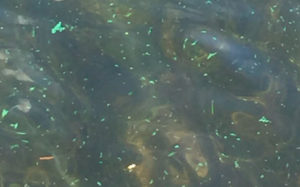FOR IMMEDIATE RELEASE
DATE: 08/17/2020
CONTACT: Amanda McQuaid (603) 271-0698 (O), 848-8094 (C)
Concord—August 17, 2020—A cyanobacteria bloom has been observed throughout Danforth Bay of Middle Danforth Pond in Freedom. The bloom was first reported on August 17, appearing as blue-green flecks throughout the water.
Samples were collected by Green Mountain Conservation Group (GMGC) and are awaiting inspection. NHDES will inspect the area tomorrow, 8/18, for follow-up. This alert is intended as a message to inform the community of the bloom.”

Cyanobacteria in middle Danforth Pond, reported on Monday, August 17.
Surface blooms can rapidly change and accumulate in various locations around a waterbody. As a result, the New Hampshire Department of Environmental Services (NHDES) has issued a cyanobacteria alert for those who use the waterbody for recreation.
Please continue to monitor your individual shorelines for changing conditions and avoid contact. The alert is not based on a toxin evaluation and is intended as a precautionary measure for short term exposure.
NHDES advises lake users to avoid contact with the water in areas experiencing elevated cyanobacteria cell conditions, also known as a bloom. NHDES also advises pet owners to keep their pets out of any waters that have a cyanobacteria bloom.
Cyanobacteria are natural components of water bodies worldwide, though blooms and surface scums may form when excess nutrients are available to the water. Some cyanobacteria produce toxins that are stored within the cells and released upon cell death. Toxins can cause both acute and chronic health effects that range in severity.
Acute health effects include irritation of skin and mucous membranes, tingling, numbness, nausea, vomiting, seizures and diarrhea. Chronic effects may include liver and central nervous system damage. Be cautious of lake water that has a surface scum, changes colors, or appears to have green streaks or blue-green flecks aggregating along the shore.
If you notice anything resembling cyanobacteria, please refrain from wading, swimming, or drinking the water. Keep all pets out of the water and contact NHDES immediately. Please call NHDES to report a cyanobacteria bloom at (603) 848-8094 or email HAB@des.nh.gov.
Visit the NHDES Beach Program website for photos and more information about cyanobacteria at: https://www.des.nh.gov/organization/divisions/water/wmb/beaches/index.htm
Updates on cyanobacteria advisories may be obtained at: http://www4.des.state.nh.us/WaterShed_BeachMaps/WaterShed_BeachMaps.aspx
Follow the Beaches twitter feed:
https://twitter.com/NHDES_Beaches

Please can you update me on the issues in Danforth Pond… When is swimming safe again?
thanks
Any update regarding swimming in the bay?
Haven’t seen an update regarding the quest above